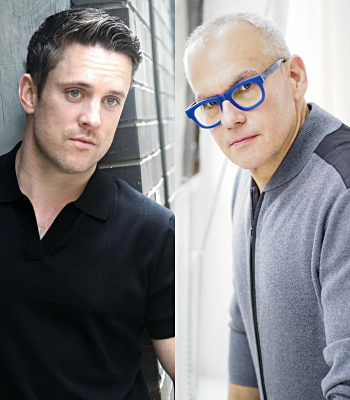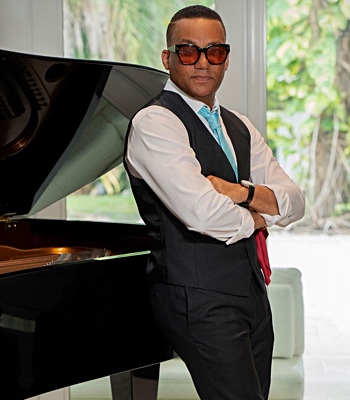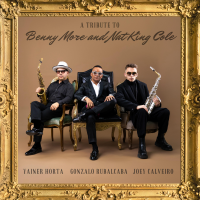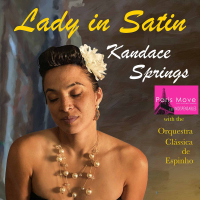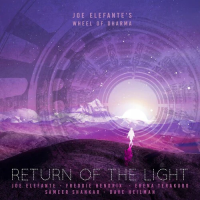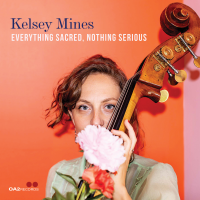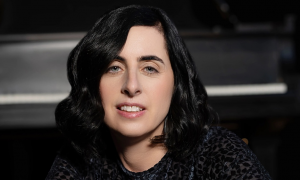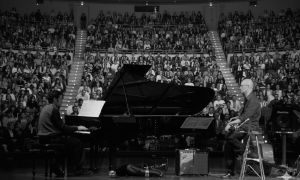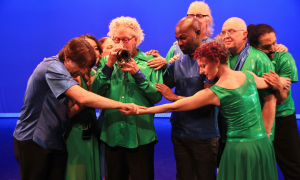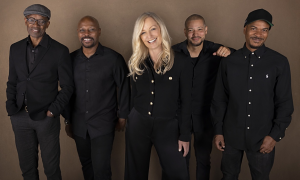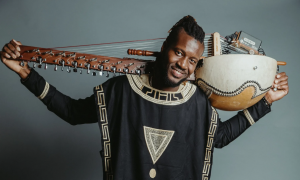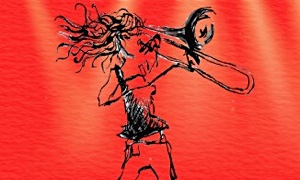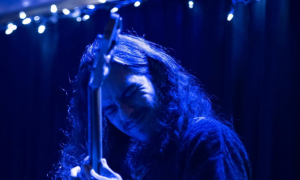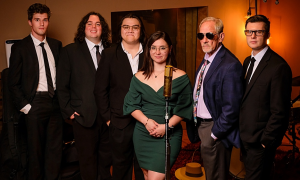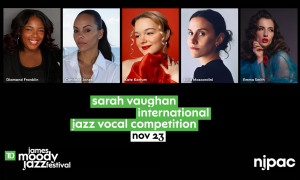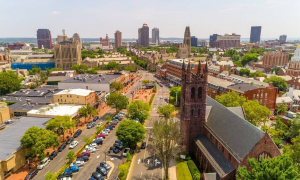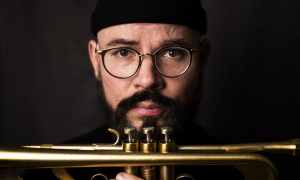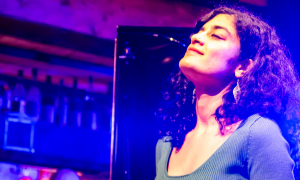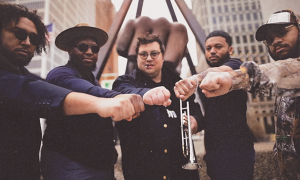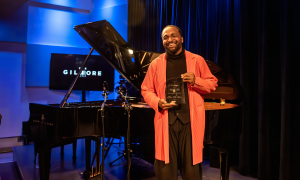Fifty years ago, Dizzy Gillespie blew “Star Spangled Banner" on his bent trumpet to herald the birth of the Monterey Jazz Festival.
No one ever had seen or heard an all-star lineup like this:
Billie Holiday, Louis Armstrong, Sonny Rollins, Ernestine Anderson, Gerry Mulligan with Art Farmer, Benny Carter, Harry James, Max Roach, Shelly Manne, Dave Brubeck, and the Modern Jazz Quartet.
Staged with $6,700 in loans, the outdoor festival in a horse arena at the County Fairgrounds got off to “a rocky, money-losing start" (the talent fee was $41,000) but founder Jimmy Lyons, an ex-San Francisco disc jockey, had a vision. He wanted to enjoy jazz “outside, in a pretty place, under the sky."
The next year, Lyons invited the Count Basie Orchestra with Joe Williams. And Ben Webster, Coleman Hawkins, Woody Herman, Cal Tjader, Oscar Peterson, Sarah Vaughan, Ornette Coleman, Lambert, Hendricks & Ross, J.J. Johnson, and the Modern Jazz Quartet.
When Duke Ellington played piano solos between set changes in 1961, critic Leonard Feather proclaimed Monterey “a resounding success?"artistically and financially."
Even George Wein, founder of Newport Jazz Festival, gave it up: “This is the best place in the world to hold a jazz festival!"
Where History Was Made
In Indian summer, always on the third weekend in September, this bayside city becomes, for one magic weekend, the jazz capital of the world.
A hip locale, Monterey's the place to hang out, see and be seen, eat BBQ ribs and sweet potato pie, buy jazz art, books and vintage MJF posters, (a '65 by Earl Newman sold recently on e-Bay for $380.09), and enjoy “one of the best summer jazz festivals anywhere," according a recent New York Times readers' poll.
It all happens at the Monterey County Fairgrounds, a 20-acre oak shaded patch of green on Monterey Bay's shore.
“The very best jazz musicians have been, are, and will be at Monterey," says William Minor, author of Monterey Jazz Festival Forty Legendary Years, “It is the American jazz event."
Site of unforgettable performances, many captured on tape, (soon to be released on CDs) Monterey's stage is where history was made:
Dave Brubeck and Paul Desmond swung into “Off we go into the wild blue yonder" as an out-bound Cessna buzzed the stage.
Duke Ellington presented “The Afro-Eurasian Eclipse."
Jon Hendricks introduced “The Evolution of The Blues."
Charles Mingus delivered an emotional “Meditations on Integration" and brought down the house on both sides of the curtain.
In 1968, on the same bill, Jimmy Rushing, Muddy Waters, B.B. King, and Big Mama Willie Mae Thornton sang the blues.
John Lee Hooker growled “Boom Boom," then kissed Etta James singing “At Last."
Roberta Flack put a spell on Monterey in '72, singing “The First Time Ever I Saw Your Face." The Pointer Sisters ("Yes, We Can-Can") launched their career here in '74.
For the 40th annual festival, Gerald Wilson, and his 19-piece orchestra performed “Theme For Monterey," a 1999 Grammy nominee for Best Large Jazz Ensemble.
As a full moon rose over Monterey in 2005, Tony Bennett, making his Monterey debut at 79, sang, “I left my heart..." (you know where) to a roaring, SRO crowd.
And then sang “Fly Me To the Moon."
Who Never Came
So many great jazz artists have appeared at Monterey over the last half-century that it's easier to name those who never came.The no-show list is surprising, author William Minor says.
“Most surprisingly, Ella Fitzgerald (when you look at all the other divas: Sarah, Carmen, Annie Ross, Anita O'Day, Betty Carter.)
“Equally surprisingly: she did appear in concert at the Pacific Grove Middle School Auditorium--before the festival itself began?"a gig set up by Lyons.
“Chet Baker? No. Chico Hamilton? Can't find any evidence of him. Why he wasn't invited, I don't know," Minor said. “Lyons had very definite likes and dislikes, and some petty grudges to boot."
Ex-officio host Dizzy Gilllespie almost always showed up. So did John Lewis, musical director. Clark Terry holds the record with 20 paid gigs.
A Different Groove
Fifty years ago, America was in a whole different groove. Eisenhower was in the White House. Elvis joined the Army. CBS introduced stereo records.
Everyone whistled the theme song from “The Bridge Over The River Kwai." Perry Como's “Catch a Falling Star" earned a gold record.
Rosanno Brazzi sang “Some Enchanting Evening," the nation's number one song for 31 weeks, until Domenico Medugno sang “Volare" in Italian. In the world of jazz, Ella Fitzgerald won a Grammy for “Ella Sings The Irving Berlin Songbook."
Miles Davis and John Coltrane recorded “Milestones." Ornette Coleman recorded “Something Else!"
Art Kane took a photo of 57 jazz artists on the steps of a Harlem brown- stone for Esquire magazine.
While America swiveled hula-hoops a coup in Iraq sparked jitters in the Middle East.
How It All Began
In 1958, Monterey, home of Fort Ord, was the most unlikely place to stage a jazz festival.
Once the capital of California, the blue-collar fishing town of adobes and wharfs on Monterey Bay served as gateway to Carmel-by-The-Sea and scenic Big Sur.
“The Crosby," a celebrity golf tournament hosted by crooner Bing Crosby in January, was the year's big event. Day-trippers came in summer to munch on abalone steaks, bark at harbor seals, walk on Carmel beach, cruise 17 Mile Drive, and head home.
After Labor Day, the tourist season “fell off a cliff," is how Lyons put it. He'd just moved from San Francisco to a cabin on a cliff in Big Sur, and he missed the city's jazz scene.
With San Francisco Chronicle columnist Ralph Gleason, he'd been kicking around the idea of an outdoor festival in Monterey.
“Gleason and I wanted to put jazz in a pretty place...outside, in the wind, under the sky, where it belongs," he wrote in Dizzy, Duke, The Count and Me The Story of the Monterey Jazz Festival. “So I started meeting with some Monterey business people."
Money, Culture, Decent People
Village elders approved of Carmel's Bach Festival but jazz--well, jazz was some-thing else. “Jazz meant black people," said Grover Sales, a friend of Lyons and his early publicity director. And those days, “there were no black people in this area.
“Jimmy had to convince the community that jazz...would not spoil the children, wilt the vegetation, or corrupt the coastline.
“He had to convince them that jazz would bring in money, culture, decent people."
Lyons set up a non-profit to aid jazz education, enlisted support of local businessmen, polled residents on racial attitudes.
He invited Dave Brubeck to “audition" before the Monterey City Council and booked Cal Tjader in Carmel's Sunset Center for the famous Concert by The Sea.
The warm-up concerts won local hearts and minds. The festival was on.
Hustle City
The whole subterranean midnight world of jazz surfaced in broad daylight in lily-white Monterey. Fans, mostly black men and women, rolled into town in big shiny Cadillacs dressed to the nines.
Some intimidating dudes wore beards and berets; leather and shades, others smoked funny cigarettes, sipped espresso, and spoke their own jive lingo.
Foursquare Monterey swung with the '60s until side streets at the fair- grounds attracted pimps and dealers pushing hookers and drugs out of parked recreational vehicles.
To curb the vice city fathers banned RV parking. Nobody lost their cool and the bands played on.
Rude Fans
In the 70s, Monterey evolved into a freewheeling party fueled by red wine and weed that upstaged and upset artists.Folks got loaded, danced in dusty aisles, ignored the musicians.
Interrupting artists with shouted requests, they blew police whistles, even leaped on stage to be part of the act.In '94, half the audience walked out as Ornette Coleman began to wail.
“I thought you came to hear the music," Monty Alexander complained.
David Friesen calmed rowdies with a moving solo bass performance of “Children of the Kingdom."
Sarah Vaughan played with bozos, introducing herself as Della Reese, but Carmen McRae, angry at rude fans, vowed never to return?"and never did.
Clamor For Change
As a generation of musicians and fans matured, Monterey fell into a malaise.The same old artists kept playing the same old tunes. Fans began to grumble.
Playbills “read like a 78 rpm top bop record list of 20 years ago," the late jazz critic Phil Elwood wrote.
Amid “growing clamor for change" Monterey “seemed to be running short of ideas," author William Minor wrote.
As years passed so did legendary artists-Duke Ellington, Paul Desmond, Cal Tjader, Woody Herman, Sarah Vaughan, Joe Williams, Carmen McRae, Harry “Sweets" Edison, Milt Jackson.
Survivors like Danny Barker, 84, Milt Hinton, 83, and Benny Carter, 80, seemed from another time and place.
The faithful still packed the house, and paid top dollar for choice seats, but change was overdue.
In 1992, Jimmy Lyons, 75, ailing with cancer, stood down. He died two years later.
Second Wind
His handpicked successor, Tim Jackson, 37, claiming to be an “evolutionist not a revolutionist," made an impressive debut.
No stranger to jazz, Jackson, a flute player, shaped Santa Cruz' non-profit Kuumbwa Jazz Center into a respected club, and knew he must be innovative and traditional at the same time to succeed in his new role.
Trumpeter Roy Hargrove, 23, opened the '92 Monterey Jazz Festival with Herbie Hancock, Ron Carter, Wayne Shorter, and Wallace Roney in a tribute to Miles Davis.
Brubeck, Gerry Mulligan and Modern Jazz Quartet closed it with a tribute to Jimmy Lyons.
Betty Carter and Wynton Marsalis celebrated The Music of Duke Ellington on Saturday night.
“The perfect blend...a unique match-up," wrote William Minor. Monterey was swinging again.
Jackson revived the annual commissioned work, originated the artist-in-residence, and booked a new, young generation of jazz artists like Joshua Redman, Regina Carter, Roberta Gambarini, and Kurt Elling.
In a torch-passing moment, he paired Ray Brown, 66 and Christian McBride, 22, on the newly christened Jimmy Lyons Stage.
Jackson upped front row Arena seats to $295 for five concerts and offered $35-a-day Grounds Tickets to attract record crowds.
The festival grossed $3.7 million last year and contributed $750,000 to educational programs, according to Paul deBarros in Downbeat magazine.
The jazzy weekend generates an estimated $1 million in Monterey hotel, restaurant, and shop receipts.
Jazz in a pretty place. Outdoors where it belongs. Money, culture, decent folks.
The vision lives on.
Big Five O
When gates swing open to the 50th annual Monterey Jazz Festival, fans will discover new music by new artists, bistros, shops, art, books, films, exhibits and clubs:
Dave Brubeck and Diana Krall, the alpha and omega of jazz today, will blow out the candles at the golden anniversary party. The guest list includes:
Sonny Rollins, Ornette Coleman, Nnenna Freelon, James Moody, Los Lobos, Benny Green, Ernestine Anderson, Kenny Burrell, Cyrus Chestnut, Christian Scott, Mimi Fox, Shigeru Morishita, and Gonzalvo Rubalcaba.
It all happens in Monterey, third week in September, when the oldest, longest, continuous--and best--jazz festival in America, hits the big Five O.
Be there or (like some of us old cats used to say) be square.
Rick Carroll, a Monterey Jazz Festival-goer since 1962, and former San Francisco Chronicle writer, is the best-selling author of IZ Voice of The People, a 2007 Kiriyama Prize Notable Book.
No one ever had seen or heard an all-star lineup like this:
Billie Holiday, Louis Armstrong, Sonny Rollins, Ernestine Anderson, Gerry Mulligan with Art Farmer, Benny Carter, Harry James, Max Roach, Shelly Manne, Dave Brubeck, and the Modern Jazz Quartet.
Staged with $6,700 in loans, the outdoor festival in a horse arena at the County Fairgrounds got off to “a rocky, money-losing start" (the talent fee was $41,000) but founder Jimmy Lyons, an ex-San Francisco disc jockey, had a vision. He wanted to enjoy jazz “outside, in a pretty place, under the sky."
The next year, Lyons invited the Count Basie Orchestra with Joe Williams. And Ben Webster, Coleman Hawkins, Woody Herman, Cal Tjader, Oscar Peterson, Sarah Vaughan, Ornette Coleman, Lambert, Hendricks & Ross, J.J. Johnson, and the Modern Jazz Quartet.
When Duke Ellington played piano solos between set changes in 1961, critic Leonard Feather proclaimed Monterey “a resounding success?"artistically and financially."
Even George Wein, founder of Newport Jazz Festival, gave it up: “This is the best place in the world to hold a jazz festival!"
Where History Was Made
In Indian summer, always on the third weekend in September, this bayside city becomes, for one magic weekend, the jazz capital of the world.
A hip locale, Monterey's the place to hang out, see and be seen, eat BBQ ribs and sweet potato pie, buy jazz art, books and vintage MJF posters, (a '65 by Earl Newman sold recently on e-Bay for $380.09), and enjoy “one of the best summer jazz festivals anywhere," according a recent New York Times readers' poll.
It all happens at the Monterey County Fairgrounds, a 20-acre oak shaded patch of green on Monterey Bay's shore.
“The very best jazz musicians have been, are, and will be at Monterey," says William Minor, author of Monterey Jazz Festival Forty Legendary Years, “It is the American jazz event."
Site of unforgettable performances, many captured on tape, (soon to be released on CDs) Monterey's stage is where history was made:
Dave Brubeck and Paul Desmond swung into “Off we go into the wild blue yonder" as an out-bound Cessna buzzed the stage.
Duke Ellington presented “The Afro-Eurasian Eclipse."
Jon Hendricks introduced “The Evolution of The Blues."
Charles Mingus delivered an emotional “Meditations on Integration" and brought down the house on both sides of the curtain.
In 1968, on the same bill, Jimmy Rushing, Muddy Waters, B.B. King, and Big Mama Willie Mae Thornton sang the blues.
John Lee Hooker growled “Boom Boom," then kissed Etta James singing “At Last."
Roberta Flack put a spell on Monterey in '72, singing “The First Time Ever I Saw Your Face." The Pointer Sisters ("Yes, We Can-Can") launched their career here in '74.
For the 40th annual festival, Gerald Wilson, and his 19-piece orchestra performed “Theme For Monterey," a 1999 Grammy nominee for Best Large Jazz Ensemble.
As a full moon rose over Monterey in 2005, Tony Bennett, making his Monterey debut at 79, sang, “I left my heart..." (you know where) to a roaring, SRO crowd.
And then sang “Fly Me To the Moon."
Who Never Came
So many great jazz artists have appeared at Monterey over the last half-century that it's easier to name those who never came.The no-show list is surprising, author William Minor says.
“Most surprisingly, Ella Fitzgerald (when you look at all the other divas: Sarah, Carmen, Annie Ross, Anita O'Day, Betty Carter.)
“Equally surprisingly: she did appear in concert at the Pacific Grove Middle School Auditorium--before the festival itself began?"a gig set up by Lyons.
“Chet Baker? No. Chico Hamilton? Can't find any evidence of him. Why he wasn't invited, I don't know," Minor said. “Lyons had very definite likes and dislikes, and some petty grudges to boot."
Ex-officio host Dizzy Gilllespie almost always showed up. So did John Lewis, musical director. Clark Terry holds the record with 20 paid gigs.
A Different Groove
Fifty years ago, America was in a whole different groove. Eisenhower was in the White House. Elvis joined the Army. CBS introduced stereo records.
Everyone whistled the theme song from “The Bridge Over The River Kwai." Perry Como's “Catch a Falling Star" earned a gold record.
Rosanno Brazzi sang “Some Enchanting Evening," the nation's number one song for 31 weeks, until Domenico Medugno sang “Volare" in Italian. In the world of jazz, Ella Fitzgerald won a Grammy for “Ella Sings The Irving Berlin Songbook."
Miles Davis and John Coltrane recorded “Milestones." Ornette Coleman recorded “Something Else!"
Art Kane took a photo of 57 jazz artists on the steps of a Harlem brown- stone for Esquire magazine.
While America swiveled hula-hoops a coup in Iraq sparked jitters in the Middle East.
How It All Began
In 1958, Monterey, home of Fort Ord, was the most unlikely place to stage a jazz festival.
Once the capital of California, the blue-collar fishing town of adobes and wharfs on Monterey Bay served as gateway to Carmel-by-The-Sea and scenic Big Sur.
“The Crosby," a celebrity golf tournament hosted by crooner Bing Crosby in January, was the year's big event. Day-trippers came in summer to munch on abalone steaks, bark at harbor seals, walk on Carmel beach, cruise 17 Mile Drive, and head home.
After Labor Day, the tourist season “fell off a cliff," is how Lyons put it. He'd just moved from San Francisco to a cabin on a cliff in Big Sur, and he missed the city's jazz scene.
With San Francisco Chronicle columnist Ralph Gleason, he'd been kicking around the idea of an outdoor festival in Monterey.
“Gleason and I wanted to put jazz in a pretty place...outside, in the wind, under the sky, where it belongs," he wrote in Dizzy, Duke, The Count and Me The Story of the Monterey Jazz Festival. “So I started meeting with some Monterey business people."
Money, Culture, Decent People
Village elders approved of Carmel's Bach Festival but jazz--well, jazz was some-thing else. “Jazz meant black people," said Grover Sales, a friend of Lyons and his early publicity director. And those days, “there were no black people in this area.
“Jimmy had to convince the community that jazz...would not spoil the children, wilt the vegetation, or corrupt the coastline.
“He had to convince them that jazz would bring in money, culture, decent people."
Lyons set up a non-profit to aid jazz education, enlisted support of local businessmen, polled residents on racial attitudes.
He invited Dave Brubeck to “audition" before the Monterey City Council and booked Cal Tjader in Carmel's Sunset Center for the famous Concert by The Sea.
The warm-up concerts won local hearts and minds. The festival was on.
Hustle City
The whole subterranean midnight world of jazz surfaced in broad daylight in lily-white Monterey. Fans, mostly black men and women, rolled into town in big shiny Cadillacs dressed to the nines.
Some intimidating dudes wore beards and berets; leather and shades, others smoked funny cigarettes, sipped espresso, and spoke their own jive lingo.
Foursquare Monterey swung with the '60s until side streets at the fair- grounds attracted pimps and dealers pushing hookers and drugs out of parked recreational vehicles.
To curb the vice city fathers banned RV parking. Nobody lost their cool and the bands played on.
Rude Fans
In the 70s, Monterey evolved into a freewheeling party fueled by red wine and weed that upstaged and upset artists.Folks got loaded, danced in dusty aisles, ignored the musicians.
Interrupting artists with shouted requests, they blew police whistles, even leaped on stage to be part of the act.In '94, half the audience walked out as Ornette Coleman began to wail.
“I thought you came to hear the music," Monty Alexander complained.
David Friesen calmed rowdies with a moving solo bass performance of “Children of the Kingdom."
Sarah Vaughan played with bozos, introducing herself as Della Reese, but Carmen McRae, angry at rude fans, vowed never to return?"and never did.
Clamor For Change
As a generation of musicians and fans matured, Monterey fell into a malaise.The same old artists kept playing the same old tunes. Fans began to grumble.
Playbills “read like a 78 rpm top bop record list of 20 years ago," the late jazz critic Phil Elwood wrote.
Amid “growing clamor for change" Monterey “seemed to be running short of ideas," author William Minor wrote.
As years passed so did legendary artists-Duke Ellington, Paul Desmond, Cal Tjader, Woody Herman, Sarah Vaughan, Joe Williams, Carmen McRae, Harry “Sweets" Edison, Milt Jackson.
Survivors like Danny Barker, 84, Milt Hinton, 83, and Benny Carter, 80, seemed from another time and place.
The faithful still packed the house, and paid top dollar for choice seats, but change was overdue.
In 1992, Jimmy Lyons, 75, ailing with cancer, stood down. He died two years later.
Second Wind
His handpicked successor, Tim Jackson, 37, claiming to be an “evolutionist not a revolutionist," made an impressive debut.
No stranger to jazz, Jackson, a flute player, shaped Santa Cruz' non-profit Kuumbwa Jazz Center into a respected club, and knew he must be innovative and traditional at the same time to succeed in his new role.
Trumpeter Roy Hargrove, 23, opened the '92 Monterey Jazz Festival with Herbie Hancock, Ron Carter, Wayne Shorter, and Wallace Roney in a tribute to Miles Davis.
Brubeck, Gerry Mulligan and Modern Jazz Quartet closed it with a tribute to Jimmy Lyons.
Betty Carter and Wynton Marsalis celebrated The Music of Duke Ellington on Saturday night.
“The perfect blend...a unique match-up," wrote William Minor. Monterey was swinging again.
Jackson revived the annual commissioned work, originated the artist-in-residence, and booked a new, young generation of jazz artists like Joshua Redman, Regina Carter, Roberta Gambarini, and Kurt Elling.
In a torch-passing moment, he paired Ray Brown, 66 and Christian McBride, 22, on the newly christened Jimmy Lyons Stage.
Jackson upped front row Arena seats to $295 for five concerts and offered $35-a-day Grounds Tickets to attract record crowds.
The festival grossed $3.7 million last year and contributed $750,000 to educational programs, according to Paul deBarros in Downbeat magazine.
The jazzy weekend generates an estimated $1 million in Monterey hotel, restaurant, and shop receipts.
Jazz in a pretty place. Outdoors where it belongs. Money, culture, decent folks.
The vision lives on.
Big Five O
When gates swing open to the 50th annual Monterey Jazz Festival, fans will discover new music by new artists, bistros, shops, art, books, films, exhibits and clubs:
- Gerald Wilson Orchestra, premiering “Monterey Moods," the 2007 original commissioned work.
- Terrence Blanchard as artist-in-residence.
- Nine stages with state-of-the-art light and sound. Arena simulcasts in the Jazz Theater.
- Lyons Lounge, a chic, new jazz club open from sundown to midnight.
- Four new Monterey Jazz Festival records, digitized from Stanford University archives.
- The Art of Jazz, a new book and exhibit of old posters and program covers.
- Film premiere of Monterey Jazz Festival-10th Anniversary.
- New Grooves in New Orleans with Dumpstaphunk, Bonerama and Papa Grows Funk.
- For the first time Borders Records & Books opens shop with jazz artists and authors signing CDs and books.
- A new book, Right Down Front Jazz Images by photographer Ron Hudson makes its national debut, celebrating nearly four decades of jazz portraits from Monterey to Montreux.
Dave Brubeck and Diana Krall, the alpha and omega of jazz today, will blow out the candles at the golden anniversary party. The guest list includes:
Sonny Rollins, Ornette Coleman, Nnenna Freelon, James Moody, Los Lobos, Benny Green, Ernestine Anderson, Kenny Burrell, Cyrus Chestnut, Christian Scott, Mimi Fox, Shigeru Morishita, and Gonzalvo Rubalcaba.
It all happens in Monterey, third week in September, when the oldest, longest, continuous--and best--jazz festival in America, hits the big Five O.
Be there or (like some of us old cats used to say) be square.
Rick Carroll, a Monterey Jazz Festival-goer since 1962, and former San Francisco Chronicle writer, is the best-selling author of IZ Voice of The People, a 2007 Kiriyama Prize Notable Book.
For more information contact All About Jazz.


